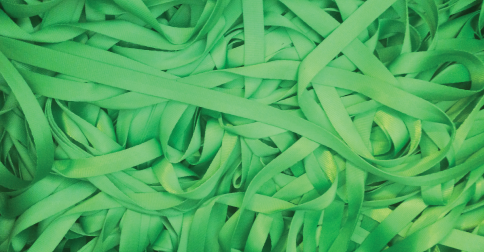You have no items in your shopping cart.
0
You have no items in your shopping cart.
Slackline webbing, the material that defines our sport. Every time we slackline, we are using some sort of slackline webbing, usually to be walked on. Because of how much we use this material and the fact that it's made from synthetic fibers, it's especially important to care for it and insure it's integrity before using - especially in life critical situations such as on a highline.
All slackline webbings are made by weaving some sort of synthetic material, usually nylon or polyester, in a flat manner. These webbings sometimes have several layers and sometimes are woven in a tubular fashion. Regardless of the weave of the webbing, the faces and edges of the webbing are fully exposed to the elements and everyday use, which make them highly susceptible to damage and wear-and-tear. When the face and/or edges of your slackline webbing are damaged, it can cause the entire webbing to be weakened and thus unsafe. This is why it is important to care for your slackline webbing and do your best to avoid the many ways that you can damage it.

Of all the possible ways to damage your slackline webbing, abrasion is probably the most common. Unlike a rope, which can roll on any surface it comes in contact with, webbing usually will slide across surfaces, which can be especially harmful to the load-bearing fibers on the face and edges of the webbing. This is why it is important to protect your webbing from any possible abrasion locations. If there is any possibility for abrasion at any location along the length of your rigged slackline, protect it with padding, or choose a different spot to setup the line.
Avoid rigging lines where the line can hit rocks or tree branches. Do not put your bare webbing on any surface while it is under tension. A tensioned webbing can cut very easily and so any movement while the webbing is in contact with something can result it the webbing getting cut.
Use cut-resistant sleeves (such as our Sidewinder Velcro Line-Sleeves) on any spot where there may be abrasion that cannot be avoided. Add additional protection to these locations by putting padding underneath or over the line (such as your backpack or a crash pad).
Even when your slackline webbing is not in use, avoid dragging it over objects or across the ground. Any sort of abrasion can introduce damage to the mono-filaments (small fibers that make up the bundles of fibers that are used for weaving). If you have damage to enough of the mono-filaments, you can significantly reduce the strength of your webbing.
Always carry your webbing when transporting it and avoid dragging it across fields or through the grass.
Dirt is the enemy for your slackline webbing! When dirt particles enter the weave of your webbing, they can start to tear apart all the mono-filaments, causing your webbing to loose strength over time. For this reason, it is important to keep your webbing off of the ground! When laying out your equipment, always put down a tarp or blanket to ensure no dirt enters the weave of your webbing (and rope).
It's also important that you do not step on your webbing when it is on the ground (even if on a tarp). Your feet and/or shoes can have dirt on them, which can work its way into your webbing and start to destroy the mono-filaments. This even applies when your line is rigged! Make sure your clean your feet or shoes of dirt that could potentially damage the line before walking it.
A pile of webbing on the ground (even on a tarp) is a very inviting bed for your pets. Try and avoid letting them lay on your slackline webbing as they can attract dirt to the webbing. The best solution is to keep the webbing in a bag and keep the bag closed. While your line is rigged, store excess webbing in a bag.
A great way to keep your line free of dirt is to always keep it in a bag and wash it when it gets especially dirty (only do so when absolutely necessary). To wash your webbing, throw it in a large bucket with warm water. Use no soap or an extremely mild soap. Avoid any soaps that contain bleach or bleach substitutes. To dry it, hang your webbing out of direct sunlight. Make sure that it is completely dry before storing.
Perhaps the most dangerous of all possible ways to damage your slackline would be exposure to chemicals. The damage done by some chemicals is completely invisible to the naked eye and can reduce the strength of your webbing by as much as 50%! Chemicals that are especially dangerous are:
For this reason, it is important to keep your webbing away from any locations that may contain a car battery or chemicals from a vehicle. Any location where a vehicle has been parked or left for extended periods of time have been known to contain some or many of these harmful chemicals. Places such as parking lots, driveways, streets, etc... Avoid putting your slackline webbing directly on these surfaces. ALWAYS put down a tarp or blanket when laying your slackline webbing and other synthetic materials on these surfaces. If possible, avoid these locations entirely.
Always store your webbing in a bag to be especially careful to avoid these types of chemicals. Whenever there is a slight doubt that your slackline webbing has touched or came in contact with a harmful chemical, retire it immediately.
Perhaps the most overlooked thing that can cause major damage to your slackline webbing is UV Radiation. When your slackline webbing is left out in the sun, the strength and integrity is slowly being destroyed. For this reason, it's important to store your webbing in a bag and out of direct sunlight. The less your line is in the sun, the better.
Another way our slackline webbing gets damaged is by repeated use. Using the same spot on your slackline webbing over and over and over again will cause repeated use damage. This is why it's especially important to change where you are anchoring your slackline webbing with each use. Attach it to your anchor at a different location each time and change which end you are using to ensure the longest lifespan. Also flip over your webbing every once in a while to change which side is facing up. Often times the top face of your webbing will receive the most damage from use and UV radiation, so it's important to change which side is up every so often.
A great way to ensure the longest lifespan for your webbing is to make a log book - recording every use of the webbing. You can record how long the line is, what end you used, and what side was up. This can also be good to keep track of your progress on the line.
Using your slackline webbing improperly can easily damage it. Your slackline webbing should only be used for slacklining and nothing else. It should only be used with approved hardware and only after reading all the specific use guidelines for that particular slackline webbing.
Note: This list is not comprehensive. There are many many ways to damage your slackline webbing, too many to list here. It is important to inspect your gear regularly before using it. If there is any doubt of the safety of your equipment, retire it from use immediately.
Now that we are aware of some of the ways we can damage our slackline webbing, what are some usage guidelines that we can follow to ensure the longest lifespan of our slackline gear?
A great way to ensure your slackline webbing is in top shape is to inspect it before every use. Since you will likely be flaking your webbing out to set it up anyway, you can run your fingers along it to check for flaws and any damage. Visually check the weave for damage as well.
Keep a usage log for your slackline webbing so that you know how it's been used over it's life. Keep a spreadsheet on your smartphone that has all your gear. This is great for tracking your slackline progress as well.
Store your webbing properly to ensure a long lifespan. Keep your webbing in a bag and out of direct sunlight. Never store when wet and clean off dirt as soon as you can.
In general, you should treat your slackline webbing as well as you can. It's important to remember that this piece of equipment will be supporting your life when rigged as a highline. Treat it as such and it will likely last much longer and your will get much more out of your investment.
Even if you treat your slackline webbing with the upmost care, it's a synthetic material that will experience wear even if not used. Below is a set of guidelines for knowing when to retire your slackline webbing.
Note: These guidelines are not set in stone. Each case is to be treated individually. It is up to the user of the slackline webbing to determine whether or not the webbing is safe or should be retired.
Average Lifespan for Slackline Webbing
Even with zero use, a slackline webbing should be retired after 10 years.
That pretty much covers the proper handling of your slackline webbing. Please note, this set of guidelines is not comprehensive and may be updated on occasion. Please feel free to suggest other guidelines in the comments below or ask any questions.
Thanks for reading.
| Product | Price | Quantity | Options | |||||
|---|---|---|---|---|---|---|---|---|
| Features |
| Availability: |
| Price |
| Options |
| Actions |

← Older Post Newer Post →
0 comments